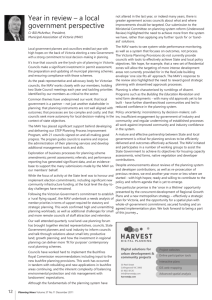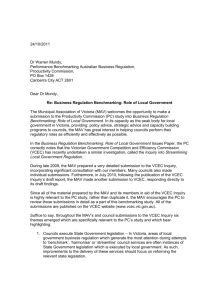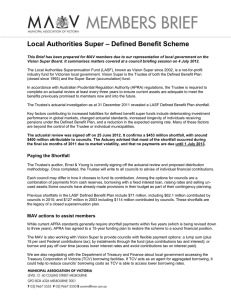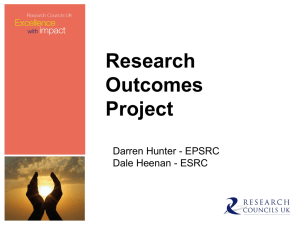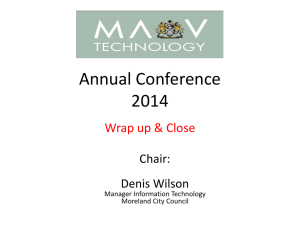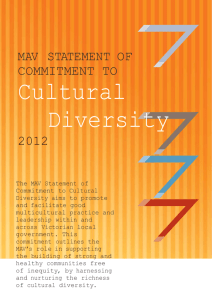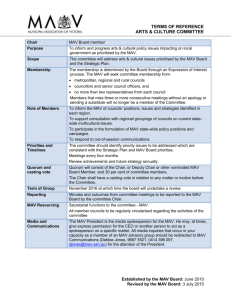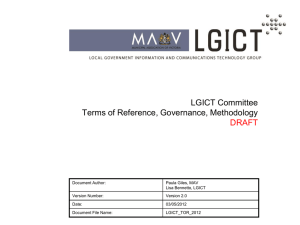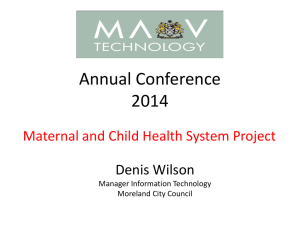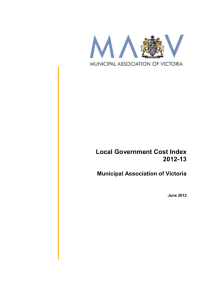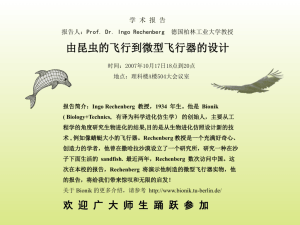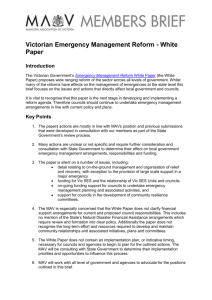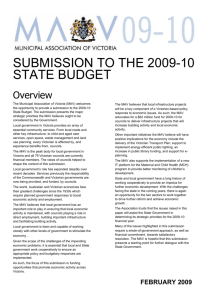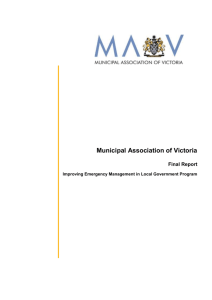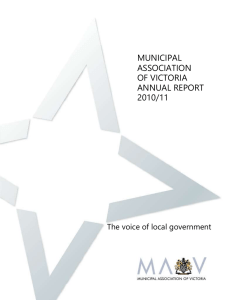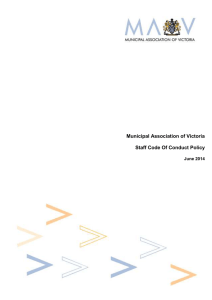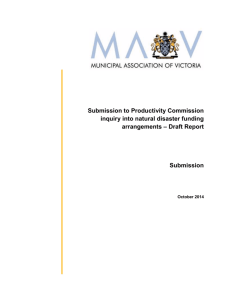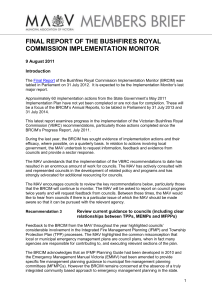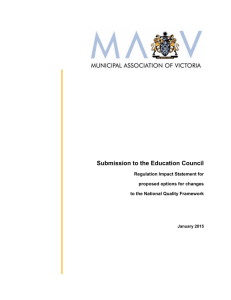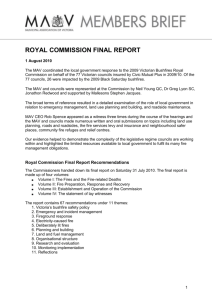Gender and emergency management strategy
advertisement
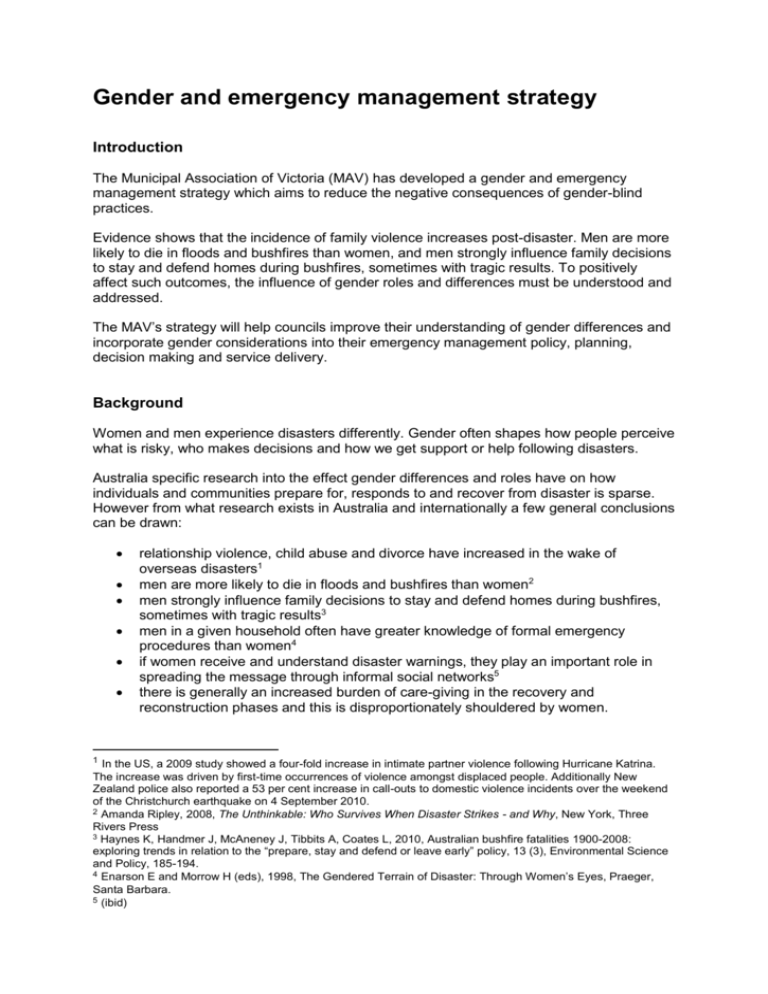
Gender and emergency management strategy Introduction The Municipal Association of Victoria (MAV) has developed a gender and emergency management strategy which aims to reduce the negative consequences of gender-blind practices. Evidence shows that the incidence of family violence increases post-disaster. Men are more likely to die in floods and bushfires than women, and men strongly influence family decisions to stay and defend homes during bushfires, sometimes with tragic results. To positively affect such outcomes, the influence of gender roles and differences must be understood and addressed. The MAV’s strategy will help councils improve their understanding of gender differences and incorporate gender considerations into their emergency management policy, planning, decision making and service delivery. Background Women and men experience disasters differently. Gender often shapes how people perceive what is risky, who makes decisions and how we get support or help following disasters. Australia specific research into the effect gender differences and roles have on how individuals and communities prepare for, responds to and recover from disaster is sparse. However from what research exists in Australia and internationally a few general conclusions can be drawn: 1 relationship violence, child abuse and divorce have increased in the wake of overseas disasters1 men are more likely to die in floods and bushfires than women2 men strongly influence family decisions to stay and defend homes during bushfires, sometimes with tragic results3 men in a given household often have greater knowledge of formal emergency procedures than women4 if women receive and understand disaster warnings, they play an important role in spreading the message through informal social networks5 there is generally an increased burden of care-giving in the recovery and reconstruction phases and this is disproportionately shouldered by women. In the US, a 2009 study showed a four-fold increase in intimate partner violence following Hurricane Katrina. The increase was driven by first-time occurrences of violence amongst displaced people. Additionally New Zealand police also reported a 53 per cent increase in call-outs to domestic violence incidents over the weekend of the Christchurch earthquake on 4 September 2010. 2 Amanda Ripley, 2008, The Unthinkable: Who Survives When Disaster Strikes - and Why, New York, Three Rivers Press 3 Haynes K, Handmer J, McAneney J, Tibbits A, Coates L, 2010, Australian bushfire fatalities 1900-2008: exploring trends in relation to the “prepare, stay and defend or leave early” policy, 13 (3), Environmental Science and Policy, 185-194. 4 Enarson E and Morrow H (eds), 1998, The Gendered Terrain of Disaster: Through Women’s Eyes, Praeger, Santa Barbara. 5 (ibid) the many informal processes of rebuilding a sense of safety, community and resilience are also largely undertaken by women6 women face exclusions or have limited participation in some forums women experience more economic vulnerability post-disaster than men men are less likely to access support to deal with trauma Not all gender difference lead to negative outcomes, or an underutilisation of skills. However it is evident that the negative outcomes that do occur are serious and require addressing. In the emergency management area, the causes of these problems are many and varied and include: gender-blindness, i.e. treating men and women the same when different approaches may be needed to achieve desired outcomes lack of knowledge and understanding of gender differences lack of knowledge of actions that can be taken to incorporate gender into decision making, policy development and service delivery individuals and/or organisations are set in ways of the past often due to primarily patriarchal legacy historical domination of emergency management sector by men men may be more likely to take risks hazards such as bushfires are still largely seen as strictly “men’s business”.7 The role of local government Local government cannot, and should not be expected to, solve all of the above problems. However they are well placed to make a substantial difference in how gender and emergency management interact, which can positively affect the protection and recovery of communities and individuals during and after a disaster. Not incorporating gender into decision making, planning, policy development and service delivery will only perpetuate gender bias and inequity. Integrating gender into decision making, policy development and service delivery can lead to a number of benefits for communities and councils: safer family and community outcomes during emergencies more efficient and effective use of council resources due to better targeting of programs, communications, services etc. reduced levels of family violence reduced levels of risk taking during an emergency a more equal and participatory community increased economic resilience increased social and community resilience increased understanding and awareness of possible risk taking behaviour increased understanding of support and services available increased understanding and awareness of the value of the roles women may play in the community 6 7 (ibid) Eriksen C, Gill N, Head L, 2010, The Gendered dimensions of Bushfire in Changing rural Landscapes in Australia, 26 (4), Journal of Rural Studies, 332-342. The Strategy This strategy outlines how the MAV and local government can influence gender related emergency management outcomes. The strategy was approved by the MAV board on May 3 2013. It is expected that the objectives and outcomes of the strategy will not change, however ongoing consultation, evaluation and analysis may require some changes to outputs and activities to ensure they effectively meet the strategy objective. Therefore the outputs and activities outlined below are indicative only. Consultation with council and other stakeholders will help to further develop and prioritise activities. For this reason no timelines or priorities are currently proposed. Scope It is not intended that this strategy will lead to an additional burden for already stretched emergency management staff. At all times care will be taken to ensure that activities are practical and efficient and designed to ensure that meeting the strategies objective becomes part of normal business. It is important to acknowledge that some of the outputs in this strategy are long-term endeavours and recognise that in order to minimise the burden on council staff some outputs may take time to implement. Objective Improve emergency management and reduce the negative consequences of gender-blind practices in local government by integrating gender into emergency management planning, decision making, policy development and service delivery. Outcomes a. gender differences are considered and reflected in emergency management policy analysis and advocacy b. Municipal Emergency Management Planning Committees and local government incorporate best practice knowledge regarding gender differences into emergency management planning, decision making, policy development and service delivery Outputs a. engage with council representatives regarding this strategy b. analyse current council engagement and inclusion of gender considerations into emergency management planning, decision making, policy development and service delivery c. analyse available data to increase insight into gender differences, roles and expectations that may affect emergency management planning, preparation, relief and recovery d. identify areas of council business to target with gender strategies and produce and disseminate information and guidance material for councils on gender and emergency management e. develop approaches to ensure gender strategies are sustained within local government f. periodically evaluate outcomes or relevant identified indicators to determine project success. Assess strategy and make evidence based changes if required Activities a. engage with council representatives regarding this strategy i. notify councils through MAV’s weekly update of development of strategy ii. obtain council feedback from interested councils iii. create reference group interested in being involved in activity design and piloting programs in their own council b. analyse current engagement and inclusion of gender considerations into emergency management planning, decision making, policy development and service delivery i. utilise existing information, including references to gender in existing plans, strategies and processes. ii. Meet with relevant gender and disaster researchers and practitioners to identify and understand issues and strategies c. analyse available data to increase insight into gender differences, roles and expectations that may affect emergency management planning, preparation, relief and recovery i. examine relevant case studies and statistics, including gender disaggregated data, at state, national and international level. d. identify areas of council business to target with gender strategies and produce and disseminate information and guidance material for councils on gender and emergency management i. consult with local government to identify gaps in knowledge ii. using results from output c. and d. (i) identify priority areas to target iii. investigate national and international best practice strategies iv. develop a gender and emergency management fact sheet outlining basic gender concepts, relevant case studies and quick easy steps council can begin to take to incorporate gender into their emergency management business e. develop approaches to ensure gender strategies are sustained within local government i. build diversity or gender agenda items into established MAV and council emergency management meetings and forums ii. include requirement for gender disaggregated data in emergency management performance measures f. periodically evaluate outcomes or relevant identified indicators to determine project success. Assess strategy and make evidence based changes if required i. develop an effective and simple evaluation strategy or integrate evaluation into another evaluation process. ii. devise ways to measure outputs or identify suitable indicators that will help identify outputs if direct measurement is infeasible iii. report to stakeholders on progress of delivering strategy outputs Key Stakeholders MAV staff council staff involved in emergency management relevant state government departments Red Cross emergency services family violence services community groups working with women, men, girls and boys
